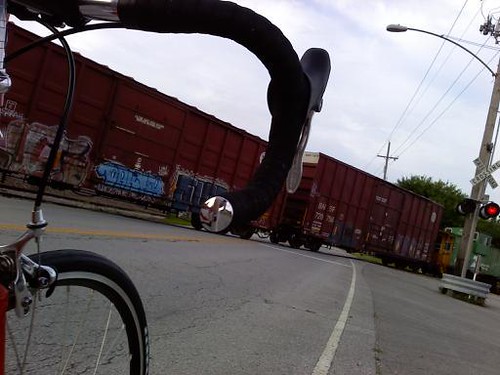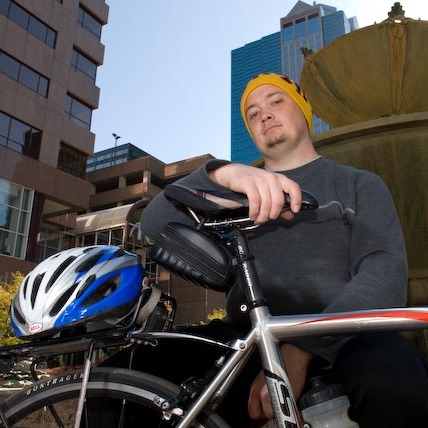I go over six distinct railroad crossings each way on my commute. That's twelve per day. Lenexa doesn't really know how to maintain these crossings, as most of them are rough to ride across. This is amplified by the fact that these are local spurs with a very odd angle-of-attack, leading off the siding next to the mainline and into small yards where only a few cars at a time get dropped off to local businesses across the street.
Some people believe these crossings are vestigial rails, no longer used. Two of the six crossings have derails off the siding track. They are smooth and easy to cross because asphalt is butted up directly against the rails. Every so often, though, I see something like this on one of the remaining four spurs:
Hey, look! A caboose!
Cabooses are still often used on local deliveries such as this one, frequently book-ending the train with the engine somewhere in the middle. A conductor acts as the eyes and ears for the engineer. The caboose also contains a gauge showing brake line air pressure and enables the conductor to initiate emergency braking for the entire train.
In case you wondered, the little blinking red light (FRED, or Flashing Rear End Device) at the trailing end of most freight trains is a computerized device that provides roughly the same function as a conductor in a caboose. It monitors brake pressure through to the back of the train and has a blow-off valve to allow the engineer to expedite emergency braking from both ends of the air hose.
At any rate, I really wish someone would do something about these horrible crossings. The angle of these crossings plus the general blighted condition of the roadway near them often makes it uncomfortable for everyone. Cyclists have to find (and memorize) a safe line through each crossing, and motorists have to be patient, as it's one big no-passing zone. Santa Fe Trail Drive isn't terribly wide, but motorists and cyclists get along quite well. I've only been honked at one time and it was friendly (meep meep!) The right part of the road is in great shape with ample room for the Kansas-mandated 4-foot passing law, except at these crossings. There, I just take the whole darn lane as needed, but many cyclists are far too sheepish to do that.
Lenexa keeps piling asphalt into these crossings, but the locomotives keep rolling through, crushing and distorting it. I'm pretty sure Lenexa's doing it wrong, and I don't think it's anyone else's responsibility (e.g., land owners, railroad companies, etc...)
On a side note, today was my first commute on the fixie. I went on a little 3-mile jaunt last night, making a mock trip to the grocery store using small residential roads and mostly-empty parking lots to get myself familiarized with fixed-gear riding. Once I broke myself of my coasting habit, everything else fell neatly into place. It was an enjoyable ride to work this morning, and it didn't really take me any longer to get here.
Update: dvicci just linked me to this gem on Dave Moulton's blog via Google Reader. How timely!
Thursday, July 08, 2010
The Trains of Santa Fe Trail Drive
Subscribe to:
Post Comments (Atom)
Privacy Policy
This site is driven by software that uses third-party cookies from Google (Blogger, AdSense, Feedburner and their associates.) Cookies are small pieces of non-executable data stored by your web browser, often for the purpose of storing preferences or data from previous visits to a site. No individual user is directly tracked by this or any other means, but I do use the aggregate data for statistics purposes.
By leaving a link or e-mail address in my comments (including your blogger profile or website URL), you acknowledge that the published comment and associated links will be available to the public and that they will likely be clicked on.
By leaving a link or e-mail address in my comments (including your blogger profile or website URL), you acknowledge that the published comment and associated links will be available to the public and that they will likely be clicked on.



3 comments:
I ride that route when I commute. I'll keep an eye out for your fixed gear.
I usually hit SFTD at Monrovia (southbound) around 7:50 in the morning. I take it to 113th, and I'm usually there by 8:05-8:10. When are you usually on the road? I've seen 5 or 6 others along this route.
I ride pretty much the whole thing some time around 6:15-6:30am and around 4:00-4:15pm in the afternoon.
Ty
Post a Comment